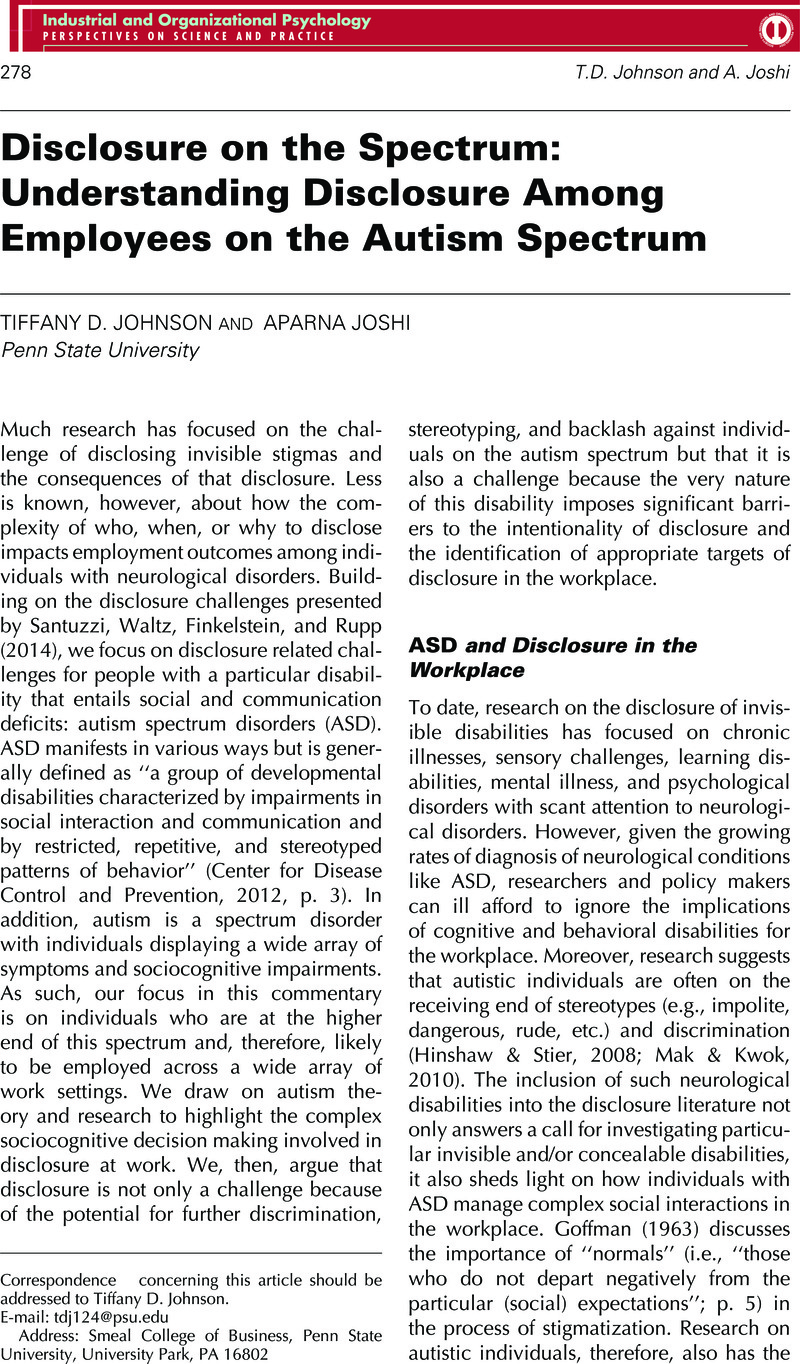Crossref Citations
This article has been cited by the following publications. This list is generated based on data provided by Crossref.
Dachez, Julie
Ndobo, Andre
and
Ameline, Anaïs
2015.
French Validation of the Multidimensional Attitude Scale Toward Persons with Disabilities (MAS): The Case of Attitudes Toward Autism and Their Moderating Factors.
Journal of Autism and Developmental Disorders,
Vol. 45,
Issue. 8,
p.
2508.
Muskat, Barbara
Greenblatt, Andrea
Nicholas, David B
Ratnapalan, Savithiri
Cohen-Silver, Justine
Newton, Amanda S
Craig, William R
Kilmer, Christopher
and
Zwaigenbaum, Lonnie
2016.
Parent and health care provider perspectives related to disclosure of autism spectrum disorder in pediatric emergency departments.
Autism,
Vol. 20,
Issue. 8,
p.
986.
Ohl, Alisha
Grice Sheff, Mira
Small, Sarah
Nguyen, Jamie
Paskor, Kelly
and
Zanjirian, Aliza
2017.
Predictors of employment status among adults with Autism Spectrum Disorder.
Work,
Vol. 56,
Issue. 2,
p.
345.
Brownlow, Charlotte
Werth, Shalene
and
Keefe, Kathleen
2018.
Work and Identity.
p.
23.
Dachez, Julie
and
Ndobo, André
2018.
The effects of descriptive, explanatory, and directive information associated with personalised interaction on the attitudes toward an adult with high-functioning autism.
Journal of Intellectual & Developmental Disability,
Vol. 43,
Issue. 1,
p.
49.
신정혜
and
김현주
2018.
Phenomenological Study on the Experiences regarding the Practices of Invisiblization among Mothers of Children with Asperger’s Disorders.
Korea Journal of Counseling,
Vol. 19,
Issue. 3,
p.
209.
Frost, Kyle M.
Bailey, Kathryn M.
and
Ingersoll, Brooke R.
2019.
“I Just Want Them to See Me As…Me”: Identity, Community, and Disclosure Practices Among College Students on the Autism Spectrum.
Autism in Adulthood,
Vol. 1,
Issue. 4,
p.
268.
Solomon, Calvin
2020.
Autism and Employment: Implications for Employers and Adults with ASD.
Journal of Autism and Developmental Disorders,
Vol. 50,
Issue. 11,
p.
4209.
Black, Melissa H.
Mahdi, Soheil
Milbourn, Benjamin
Scott, Melissa
Gerber, Alan
Esposito, Christopher
Falkmer, Marita
Lerner, Matthew D.
Halladay, Alycia
Ström, Eva
D'Angelo, Axel
Falkmer, Torbjorn
Bölte, Sven
and
Girdler, Sonya
2020.
Multi‐informant International Perspectives on the Facilitators and Barriers to Employment for Autistic Adults.
Autism Research,
Vol. 13,
Issue. 7,
p.
1195.
Romualdez, Anna Melissa
Heasman, Brett
Walker, Zachary
Davies, Jade
and
Remington, Anna
2021.
“People Might Understand Me Better”: Diagnostic Disclosure Experiences of Autistic Individuals in the Workplace.
Autism in Adulthood,
Vol. 3,
Issue. 2,
p.
157.
Anderson, Connie
Butt, Catherine
and
Sarsony, Clare
2021.
Young Adults on the Autism Spectrum and Early Employment-Related Experiences: Aspirations and Obstacles.
Journal of Autism and Developmental Disorders,
Vol. 51,
Issue. 1,
p.
88.
Lorenz, Timo
Brüning, Chelsea Rebecca
Waltz, Mitzi
and
Fabri, Marc
2021.
Not a stranger to the dark: discrimination against autistic students and employees.
Advances in Autism,
Vol. 7,
Issue. 1,
p.
60.
Tomczak, Michał T.
2021.
Employees With Autism Spectrum Disorders in the Digitized Work Environment: Perspectives for the Future.
Journal of Disability Policy Studies,
Vol. 31,
Issue. 4,
p.
195.
Romualdez, Anna Melissa
Walker, Zachary
and
Remington, Anna
2021.
Autistic adults’ experiences of diagnostic disclosure in the workplace: Decision-making and factors associated with outcomes.
Autism & Developmental Language Impairments,
Vol. 6,
Issue. ,
Athamanah, Lindsay S.
White, Keeley
Sung, Connie
Fisher, Marisa H.
and
Leader, Geraldine
2022.
Employers' Perspectives on Individuals With IDD in Community Integrated Employment Settings: A Scoping Review.
Inclusion,
Vol. 10,
Issue. 3,
p.
226.
Roy, Manon Le
Souville, Marc
and
Fonseca, David Da
2022.
Les freins psychosociaux à l’insertion professionnelle des adultes présentant un trouble du spectre de l’autisme sans déficience intellectuelle : revue de questions et pistes de réflexion.
L’Orientation scolaire et professionnelle,
Vol. 51/3,
Issue. ,
Unger, Darlene D.
Sansosti, Frank J.
and
Novotny, Allison M.
2022.
Postsecondary Transition for College- or Career-Bound Autistic Students.
p.
13.
Cope, Rosie
and
Remington, Anna
2022.
The Strengths and Abilities of Autistic People in the Workplace.
Autism in Adulthood,
Vol. 4,
Issue. 1,
p.
22.
Mpofu, Elias
Tomczak, Michał T.
Hutson, Nathan
Gafford, Lucy
and
Zhan, Rongfang
2022.
Managing Human Resources.
p.
269.
Tomas, Vanessa
Hsu, Shaelynn
Kingsnorth, Shauna
Anagnostou, Evdokia
Kirsh, Bonnie
and
Lindsay, Sally
2023.
Development and Usability Testing of a Web-Based Workplace Disability Disclosure Decision Aid Tool for Autistic Youth and Young Adults: Qualitative Co-design Study.
JMIR Formative Research,
Vol. 7,
Issue. ,
p.
e44354.



